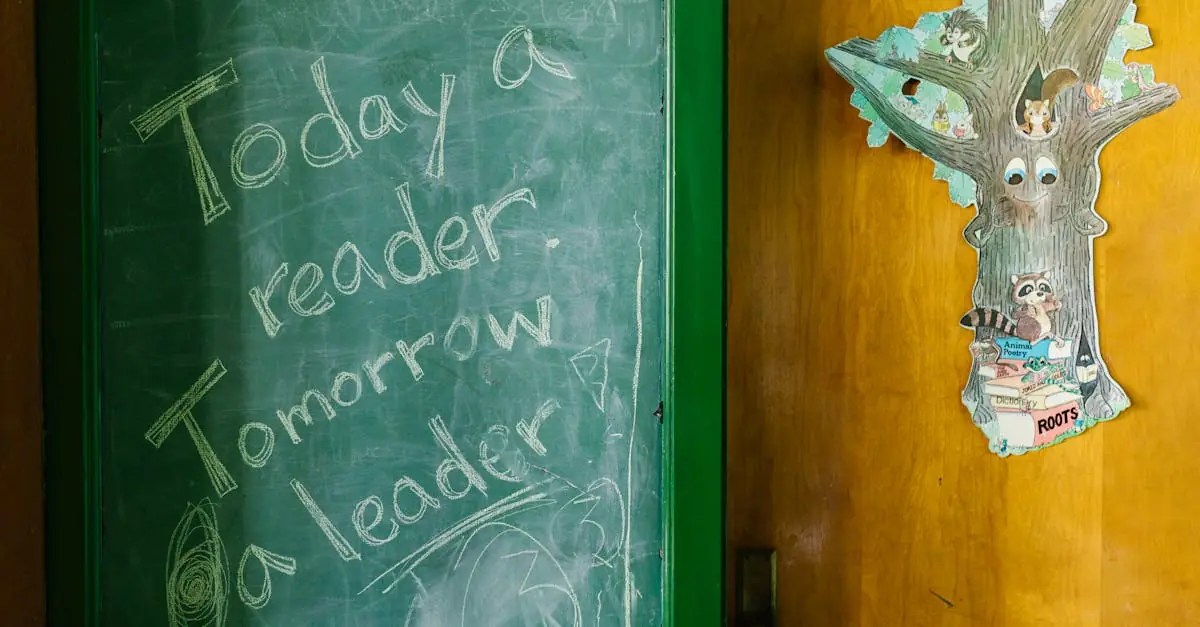Education is supposed to be the great equalizer, but lately, it feels more like a game of dodgeball where students are the targets. From outdated curriculums to the ever-growing student debt, the challenges in today’s education system are enough to make anyone want to pull their hair out. And let’s not even get started on the tech divide—because who needs a laptop when you can learn on a chalkboard, right?
Table of Contents
ToggleOverview of Major Issues in Education Today
Outdated curriculums impede student engagement and preparedness for modern careers. Schools often rely on materials that don’t reflect current knowledge or skills needed in the workforce. Rising student debt poses a significant barrier to access and equity. According to the Federal Reserve, Americans owed over $1.7 trillion in student loans as of 2021, stressing the financial burdens on many.
The technology gap further complicates the educational landscape. Students in underserved communities often lack access to essential resources, such as reliable internet and up-to-date devices. This disparity creates challenges, making remote learning difficult for those without adequate support.
Moreover, teacher shortages affect classroom quality and effectiveness. The National Center for Education Statistics revealed that nearly 300,000 teachers left the profession in the 2021-2022 school year. These shortages often lead to larger class sizes and increased workloads for remaining educators, impacting student learning experiences.
Students face mental health challenges, often exacerbated by academic pressures and social dynamics. The CDC reported that over 40% of high school students experienced persistent feelings of sadness or hopelessness in 2021. Such mental health struggles can hinder academic achievement and overall well-being.
Equity in education remains a pressing concern. Students from marginalized communities encounter systemic barriers, such as lack of funding and resources. Addressing these disparities is vital for fostering a just educational environment where all learners can thrive.
Funding and Resource Allocation
Funding and resource allocation remain critical issues impacting education. The financial disparities between school districts contribute significantly to unequal educational opportunities.
Disparities in Funding
Funding disparities exist across districts, often based on local property taxes. Wealthier communities can allocate more resources, while low-income areas struggle for essential funds. This inequity creates stark differences in educational quality and access to opportunities. Underfunded schools frequently lack vital resources such as textbooks, technology, and extracurricular programs. Data from the National Center for Education Statistics shows that schools serving predominantly low-income students receive about 20% less funding per student compared to their wealthier counterparts. As a result, students in underfunded districts often face barriers that limit their potential for success.
Impact on Educational Quality
Educational quality suffers in districts with inadequate funding. Teachers in these schools often juggle increased class sizes and limited resources, leading to diminished student support. Students are less likely to engage fully in their education due to overcrowded classrooms and outdated materials. Moreover, essential programs like art and music frequently face cuts, depriving students of a well-rounded learning experience. Research indicates that underfunded schools produce lower academic outcomes, contributing to the persistent achievement gaps. Significant funding gaps restrict schools’ ability to attract and retain qualified teachers, further exacerbating the overall decline in educational quality.
Access to Education
Access to education remains a pressing issue, particularly influenced by socioeconomic status and geographic location. Barriers exist that prevent equal opportunities for all students.
Socioeconomic Barriers
Socioeconomic barriers significantly impact students’ access to quality education. Families with low income often face challenges such as inadequate transportation, food insecurity, and limited access to the internet. These challenges create a cycle of disadvantage, where students struggle to keep up with peers from wealthier backgrounds. Research shows that low-income students are less likely to graduate high school and pursue higher education. Approximately 25% of students in low-income households face these obstacles. This disparity emphasizes the need for comprehensive support systems that address financial limitations. Schools serving these communities frequently lack essential resources, decreasing educational quality and perpetuating inequity.
Geographic Challenges
Geographic challenges further complicate access to education, particularly in rural areas. Students living in remote locations encounter limited educational resources, including access to experienced teachers and advanced coursework. Geographic isolation can restrict access to extracurricular activities and enrichment programs often available in urban settings. According to a 2020 report, nearly 10 million students live in areas without adequate educational opportunities. Rural schools typically experience higher teacher turnover rates, leading to inconsistent educational experiences for students. Increased investment in broadband internet and transportation can help bridge these gaps and enhance educational access. Addressing these geographic challenges is crucial for creating equitable educational environments for all learners.
Technological Integration
Technological integration plays a crucial role in shaping education today. It enhances learning experiences, offering diverse tools that cater to various learning styles.
Benefits of Technology in Education
Technology provides personalized learning experiences, enabling students to learn at their own pace. Access to educational resources expands beyond traditional classrooms, allowing students to explore subjects deeply. Interactive tools engage learners, fostering greater participation and collaboration. Additionally, technology supports remote learning, ensuring continuity during disruptions. A report from the U.S. Department of Education highlights that 75% of students believe technology makes learning more enjoyable.
Challenges and Limitations
Despite its benefits, technology presents significant challenges in education. The digital divide exacerbates disparities, leaving underserved students without necessary devices or high-speed internet access. Over-reliance on technology can lead to decreased interpersonal skills, hindering collaborative learning. Furthermore, cybersecurity concerns raise risks related to personal data safety and privacy. Educators often face hurdles in effectively integrating technology into curricula, with more than 60% citing inadequate training as a barrier. Addressing these limitations proves crucial to maximizing technology’s potential in education.
Curriculum Relevance
Curriculum relevance stands as a critical issue in today’s education landscape. Outdated content fails to engage students and prepare them for careers in a rapidly evolving job market.
Adapting to Modern Needs
Students need curriculums that reflect contemporary skills and knowledge. Critical thinking, digital literacy, and problem-solving emerge as essential abilities. Schools must redesign their programs to incorporate these skills effectively. Integrating real-world applications into lessons enhances student engagement and relevance. Programs that focus on hands-on experiences align with future workforce demands. Additionally, partnerships with industries can create more dynamic learning opportunities. Ultimately, a curriculum that adapts to modern needs equips students better for success in a changing world.
Standardized Testing Concerns
Standardized testing raises significant concerns regarding its impact on education quality. These assessments often emphasize rote memorization over critical thinking. With over 40% of educators questioning the effectiveness of these tests, it becomes essential to explore alternatives. Tests disproportionately affect low-income and minority students, exacerbating existing achievement gaps. Schools should prioritize formative assessments that provide ongoing feedback and support. Innovative evaluation methods allow for a more comprehensive understanding of student capabilities. Emphasizing personalized learning experiences reduces the pressure associated with standardized tests. Addressing these testing concerns creates a fairer assessment landscape for all students.
Teacher Support and Retention
Teacher support and retention present significant challenges in today’s educational landscape. High levels of teacher burnout contribute to many educators leaving the profession. In the 2021-2022 school year, nearly 300,000 teachers exited, leading to larger class sizes and increased workloads for those who remain. Stressors like inadequate support and excessive administrative duties exacerbate feelings of exhaustion among teachers. Collaborative environments improve retention, as sharing best practices and resources can create a sense of community.
Professional development plays a crucial role in enhancing teacher retention. Ongoing training equips educators with skills to adapt to evolving curricula and classroom dynamics. Effective professional development programs emphasize practical strategies for immediate classroom application. Educators benefit most when they receive regular opportunities for collaboration and mentorship. Investing in comprehensive training fosters skill growth and boosts educator confidence, ultimately leading to increased job satisfaction and reduced turnover.
The landscape of education today is fraught with challenges that hinder the potential of students and educators alike. From outdated curriculums to rising student debt and significant resource disparities, the system struggles to create equitable opportunities for all learners. The technology gap and teacher shortages further complicate matters, impacting classroom quality and student engagement.
Addressing these issues requires a collective effort to redesign educational frameworks, invest in resources, and prioritize mental health support. By fostering an environment that values equity and innovation, it’s possible to pave the way for a more inclusive and effective education system that meets the needs of every student.



